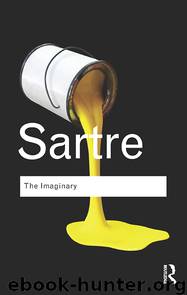The Imaginary by Sartre Jean-Paul

Author:Sartre, Jean-Paul
Language: eng
Format: epub
Tags: Humanities
Publisher: Taylor & Francis
Published: 2010-02-25T16:00:00+00:00
Part III
The Role of the Image in Psychic Life
I. THE SYMBOL1
The image plays neither the role of illustration nor that of support for thought. It is not something heterogeneous with thought. An imaging consciousness includes knowledge, intentions, and can include words and judgements. And by that I do not mean to say that one can judge about the image, but that judgements in a special form, the imaging form, can enter into the very structure of the image. If I want, for example, to represent to myself the staircase of a house that I have not been to for a long time, I ‘see’ at first a staircase of white stone. Several steps appear to me in a fog. But I am not satisfied, something is missing. I hesitate for a moment, I search in my memories, without leaving for that the imaging attitude; then, all at once, with the clear impression of engaging myself, of taking my responsibilities, I make a carpet with copper rods appear on the stone steps. This is here a good case of an act of my thought, of a free and spontaneous decision. But this decision did not pass through a stage of pure knowledge (connaissance) or a simple verbal formulation. The act by which I engaged myself, the act of affirmation was precisely an imaging act. My assertion consisted exactly in conferring on the object of my image the quality ‘covered by a carpet’. And I made this quality appear on the object. But this act is evidently a judgement since, as has been well shown by the research of the Würzburg school, the essential characteristic of judgement is decision. Into the imaging consciousness there enters therefore a particular type of judgement: imaging assertions. In a word (we will see later that one can even have reasoning in images, which is to say necessary connections of imaging consciousnesses) the ideational elements of an imaging consciousness are the same as those of the other consciousnesses for which one ordinarily reserves the name thoughts. The difference resides essentially in a general attitude. What one ordinarily calls thought is a consciousness that affirms this or that quality of its object but without realizing it on it. The image, on the other hand, is a consciousness that aims at producing its object: it is therefore constituted by a certain way of judging and feeling of which we do not become conscious as such but which we apprehend on the intentional object as this or that of its qualities. This can be expressed in a word: the function of the image is symbolic.
For some years much has been written, no doubt under the influence of psychoanalysis, on symbolic thought. But one is always struck by a conception that makes the image a material trace, an inanimate element that afterwards plays the role of a symbol. Most psychologists make of thought an activity of selection and organization that would fish for its images in the unconscious, to arrange and
Download
This site does not store any files on its server. We only index and link to content provided by other sites. Please contact the content providers to delete copyright contents if any and email us, we'll remove relevant links or contents immediately.
| Deconstruction | Existentialism |
| Humanism | Phenomenology |
| Pragmatism | Rationalism |
| Structuralism | Transcendentalism |
| Utilitarianism |
The remains of the day by Kazuo Ishiguro(8821)
Tools of Titans by Timothy Ferriss(8218)
Giovanni's Room by James Baldwin(7191)
The Black Swan by Nassim Nicholas Taleb(7010)
Inner Engineering: A Yogi's Guide to Joy by Sadhguru(6725)
The Way of Zen by Alan W. Watts(6505)
Asking the Right Questions: A Guide to Critical Thinking by M. Neil Browne & Stuart M. Keeley(5633)
The Power of Now: A Guide to Spiritual Enlightenment by Eckhart Tolle(5605)
The Six Wives Of Henry VIII (WOMEN IN HISTORY) by Fraser Antonia(5396)
Astrophysics for People in a Hurry by Neil DeGrasse Tyson(5133)
Housekeeping by Marilynne Robinson(4347)
12 Rules for Life by Jordan B. Peterson(4250)
Double Down (Diary of a Wimpy Kid Book 11) by Jeff Kinney(4207)
The Ethical Slut by Janet W. Hardy(4173)
Skin in the Game by Nassim Nicholas Taleb(4162)
Ikigai by Héctor García & Francesc Miralles(4125)
The Art of Happiness by The Dalai Lama(4063)
Skin in the Game: Hidden Asymmetries in Daily Life by Nassim Nicholas Taleb(3929)
Walking by Henry David Thoreau(3894)
